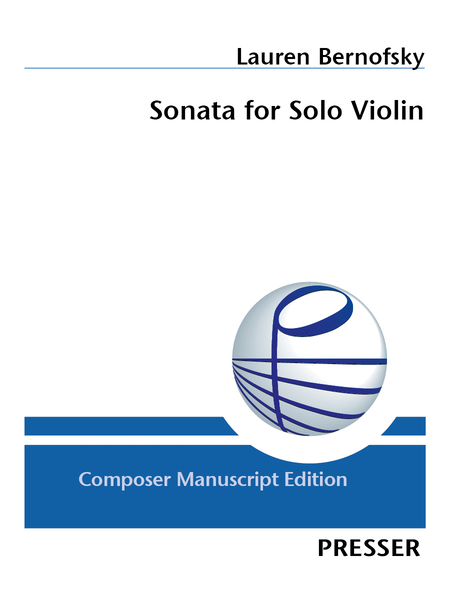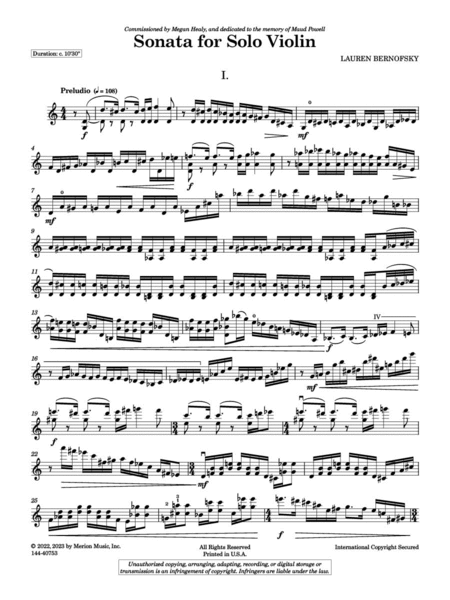Sonata for Solo Violin
-
Ships in 1 to 2 weeks
Details
Description
SKU: PR.144407530
Composed by Lauren Bernofsky. 12 pages. Duration 10 minutes, 30 seconds. Merion Music #144-40753. Published by Merion Music (PR.144407530).ISBN 9781491136614. UPC: 680160687992.
A violinist herself, Lauren Bernofsky has described SONATA FOR SOLO VIOLIN as drawn from autobiographical inspiration, including gestures from Bach’s beloved Partita in E Major. Bernofsky opens with a Preludio movement whose references to Bach may be disguised, but they are surely lurking. The second movement is lusciously contrapuntal with the idiomatic finesse of a violinist composing for her own instrument, while musically journaling the emotional pain of living through 2020. The third and final movement is aptly marked “white-hot,” and the music certainly is.
My SONATA FOR SOLO VIOLIN was commissioned by violinist Megan Healy as part of The Maud Powell Project, which celebrated the 100th anniversary of the ratification of the 19th Amendment. The project included the creation of five new works for solo violin inspired by and dedicated to the memory of pioneering American violinist Maud Powell (1867-1920). Healy premiered the sonata on May 8, 2021 at PianoForte Studios in Chicago.Among the works Powell most frequently performed in her recitals was the “Preludio” movement from Bach’s E major Partita, and I decided to refer to that music in my own first movement, also titled “Preludio.” The beginning subtly reflects Bach’s opening three-note motive, wherein the music dips down a semitone and then comes back up. This melodic material returns throughout the movement in various forms. I also refer to Bach’s sixteenth-note dominated texture, and the gesture in the third measure, which outlines a perfect fifth and then fills it in with notes that alternate between a scale and a pedal tone. The corresponding passage in my piece occurs in the same place, measure 3. Apart from these references to Bach, my sonata is much more modern sounding, especially in its chromatic character.I was still thinking of Bach’s solo violin writing while composing the second movement, particularly the polyphonic nature of the slow movements, where the melodic interest moves around between the voices. Emotionally, I wanted my movement to reflect the acute sadness I had been experiencing over the political and social situation in the United States as I wrote the piece. I realized that this is a historically noteworthy time in U.S. history, marked not only by political unrest, but also by a challenge to the very values that I consider essential to what makes a person fundamentally human. I wanted to create a record of that pain in my music.The final movement is marked “White-hot.” It is imbued with a relentless, passionate intensity. Wanting again to reflect aspects of our own time, I included glissandi that refer to rock music, specifically the “fall-offs” I frequently hear played by electric guitarists. I borrowed from another (completely different) musical tradition as well, one that is near-and-dear to my heart: Klezmer. Klezmer (Eastern European Jewish folk music) is characterized in part by scales colored by augmented seconds, and is often performed by solo instrumentalists who improvise embellishments like quick grace notes. The second, more lyrical theme in this movement is my nod to Klezmer style.While this piece is an homage to Maud Powell, I also think of it as my own musical autobiography, as it combines some of my favorite aspects of music, and is played on my own instrument.
Song List (3)
- I.
- II.
- III.


 Share
Share